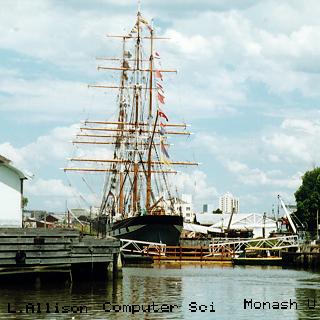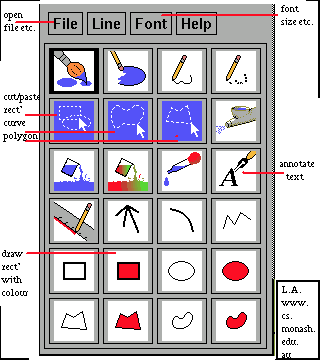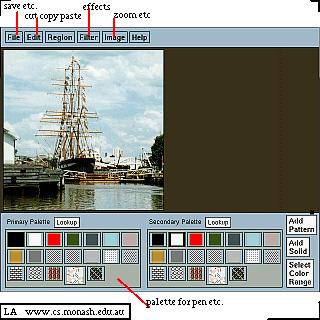[HTML] [Images]
Image Editing
- Important Matters:
- cut, paste
- colour palette
- ethics, copyright
|
It has always been possible to
edit images - using scissors, paste or the dark-room -
but computers have made it much easier
to "improve" images
and to create images of events that never occurred.
Editing

|
So you spend lots of money sending a photographer
to portray the Polly Woodside and the picture is "spoilt"
by an intrusive shed (left) and tree (right).
|

This picture altered by computer.
|
With a paint program, such as xpaint,
you cut out a few clouds and paste them over the tree and the shed.
This leaves a troublesome hole on the left so one of the low buildings
is cut out and duplicated.
Finally a piece of sky is captured as a 16x16 pattern
and, zooming to 3x magnification,
the pen is used to tidy up any of the loose pixels on the new skyline.
|
Manipulating images raises ethical questions.
Australian newspapers seem to observe a code of practice
under which they acknowledge manipulation of images.
There is a range in the degree of manipulation:
- "Enhancement" - e.g. sharpening, changing contrast.
- "Improvement" - e.g. removal of troublesome highlights.
- "Manipulation" - e.g. the fashion model's eyes are changed
from brown to blue.
- "Fabrication" - e.g. cut and paste with several images,
removal or addition of "evidence".
Newspapers, magazine, even web sites,
may be used by historians in years to come
and it is important to indicate what is true or fake now.
Some cases to consider:
- We paint out the noisy freeway in an advertising photograph of a hotel.
- Melbourne's cloudy sky is "enhanced" by replacing it
with a blue one "borrowed" from Queensland.
- A person is painted into a situation they were never in.
- The gun in a photograph of a murder site is moved, deleted, or added.
Watch Media-Watch on ABC TV.

|
The main control panel for xpaint.
The 2nd row allows areas - rectangles, curves, polygons -
to be selected for image editing, cutting and pasting.
|

|
Left: an image window (half size) in xpaint.
Multiple images can be open at one time,
also new canvases - see [File].
Selected areas can be cut, copied and pasted between images -
see [Edit].
Fine pixel work requires zoom - see [Image].
|
Copyright
Remember that the original artist
holds the copyright to a photograph, drawing, painting etc.
The fact that it may have been displayed on the internet
only gives an implied right to view it for personal use,
not a right to republish it in your own web pages etc.
Processing the image in some way, or changing its form
or the media that it is stored on does not get around copyright law.
If in doubt, ask the (real) copyright holder for permission.
Copyright ©
L.Allison
Department of Computer Science, Monash University, Australia 3168
/ 1997



